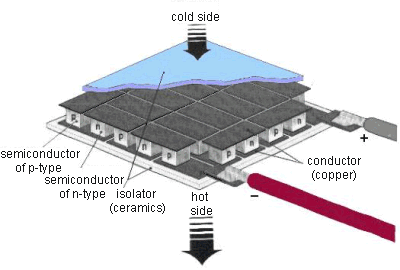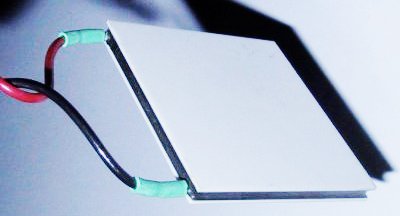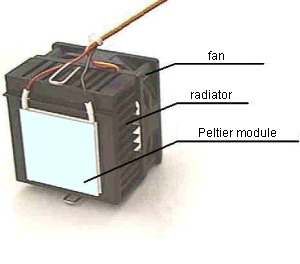The Peltier effect is the phenomenon that a potential difference applied across a thermocouple causes a temperature difference between the junctions of the different materials in the thermocouple.
This effect is the opposite of the Seebeck effect (named after the scientist who discovered it in 1821). The Seebeck effect is that if different metals are connected in two separate places, and the intersections are kept at different temperatures, then a potential difference between the "junctions" (the intersections) will result.
Later, in 1834, Jean Peltier found that the opposite of the Seebeck
effect is also true: that a potential difference (and thus a current)
can cause a temperature difference, regardless of what the ambient
temperature is.

Since the hot junction can be placed outside of an insulated area, and the cold junction can be placed inside the region, the Peltier effect can be used to cool a region (or an object).
Peltier Elements (Thermo-electric coolers)
The method of thermoelectric cooling (using the Peltier effect) is useful because it can cool an object without any moving pieces or other complex machinery that isolates the cooler from its ambient surroundings. The devices that are constructed to take advantage of this phenomenon are known as Peltier elements, or thermo-electric coolers (TECs). The basic ideas from the simple Peltier elements can be connected in series to construct far more complicated Peltier modules (also known as practical TECs), which have greater cooling capabilities. However, the greatest temperature difference between the heat sink and the cool region for a Peltier device is on the order of 50°C.
Common uses for Pelier elements include cooling computer components, especially the CPU.
The most common combination of materials in the thermocouples of Peltier elements (TECs) are the two semiconductors Bismuth and Telluride. Generally, a TEC has an array of cubes or pellets made of the semiconductors, each of which is in contact with the radiators on the hot and cold side of the Peltier element. These cubes are "doped" -- that is to say that extra impurities are added so that there are extra or fewer free electrons in each cube. The semiconductor cubes with extra free electrons (and thus carry mainly negative charge) are known as N-type semiconductors, while those with few free electrons (and carry mainly postive charge) are P-type semiconductors. The pairs of P and N semiconductor cubes are set up and connected in an array so that the pairs have an electrical series connection, but a thermal parallel connection. When a current is applied to this system (the TEC), the way the current flows through the semiconductors induces a temperature difference, and causes the heat-sink side of the Peltier element to heat up, and the cold side to cool (or cooling whatever is in thermal contact with that side).
The heat-sink side of the TEC gets very hot, so it is necessary to have a fan and/or some sort of radiator to dissipate this heat. Otherwise, the entire TEC would begin to heat up, and pieces would fuse together.
"Normal" Peltier elements are roughly a few centimeters thick and a few millimeters or centimeters on a side. To obtain greater cooling abilities, the individual elements are connected in stacks, or they can be connected in some combination of series and parallel electrical connections.
.

Since the hot junction can be placed outside of an insulated area, and the cold junction can be placed inside the region, the Peltier effect can be used to cool a region (or an object).
Peltier Elements (Thermo-electric coolers)
The method of thermoelectric cooling (using the Peltier effect) is useful because it can cool an object without any moving pieces or other complex machinery that isolates the cooler from its ambient surroundings. The devices that are constructed to take advantage of this phenomenon are known as Peltier elements, or thermo-electric coolers (TECs). The basic ideas from the simple Peltier elements can be connected in series to construct far more complicated Peltier modules (also known as practical TECs), which have greater cooling capabilities. However, the greatest temperature difference between the heat sink and the cool region for a Peltier device is on the order of 50°C.
Common uses for Pelier elements include cooling computer components, especially the CPU.
The most common combination of materials in the thermocouples of Peltier elements (TECs) are the two semiconductors Bismuth and Telluride. Generally, a TEC has an array of cubes or pellets made of the semiconductors, each of which is in contact with the radiators on the hot and cold side of the Peltier element. These cubes are "doped" -- that is to say that extra impurities are added so that there are extra or fewer free electrons in each cube. The semiconductor cubes with extra free electrons (and thus carry mainly negative charge) are known as N-type semiconductors, while those with few free electrons (and carry mainly postive charge) are P-type semiconductors. The pairs of P and N semiconductor cubes are set up and connected in an array so that the pairs have an electrical series connection, but a thermal parallel connection. When a current is applied to this system (the TEC), the way the current flows through the semiconductors induces a temperature difference, and causes the heat-sink side of the Peltier element to heat up, and the cold side to cool (or cooling whatever is in thermal contact with that side).
 An
inside view of a TEC (Peltier element).
<http://www.digit-life.com/articles/peltiercoolers/p6.gif> |
 A Peltier element, with
ceramic plates to partially insulate
the inside from the outer environment. <http://www.heatsink-guide.com/peltier.jpg> |
The heat-sink side of the TEC gets very hot, so it is necessary to have a fan and/or some sort of radiator to dissipate this heat. Otherwise, the entire TEC would begin to heat up, and pieces would fuse together.
"Normal" Peltier elements are roughly a few centimeters thick and a few millimeters or centimeters on a side. To obtain greater cooling abilities, the individual elements are connected in stacks, or they can be connected in some combination of series and parallel electrical connections.
 A Peltier module with a fan and radiator to dissipate heat from the heat sink. <http://www.digit-life.com/articles/peltiercoolers/p6.gif> |
| Home | Vapor-Compression Refrigeration | The Peltier Effect and Thermoelectric Cooling | Laser Cooling and Optical Molasses | Magnetic Cooling | References |
| S H Price 26 March 2007 Physics 212 Web Project |